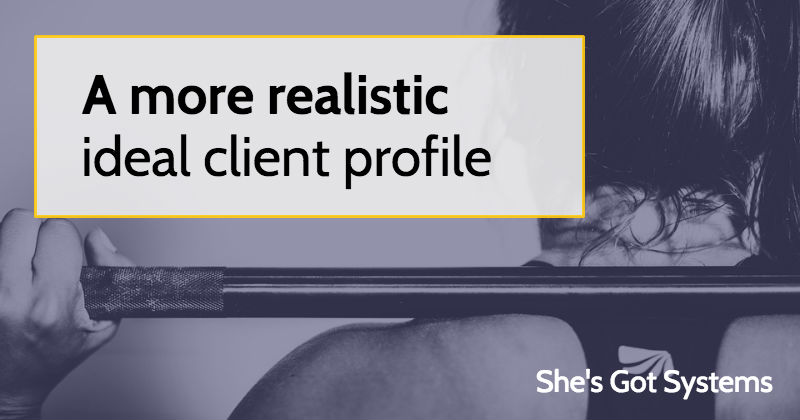Most of the time when I hear about an ideal client profile they are wildly unrealistic and overly detailed pieces of prose that tell an entrepreneur that if you don’t know your prospect’s favorite color then they’re just not a good fit.
*cough*bullshit*cough*
And while I wish I could shuffle it off into the “unnecessary work” category, it is actually a very useful process to go through.
This process is more than a marketing tool that will help you address the right client in your videos and blogs.
The ideal client profile is more than a filtering process for your lead conversion process where you decide if someone who is interested is a good fit or better off working with someone else.
First and foremost writing a client profile will unveil what kind of business you have and want. Let me give you a few examples.
Maybe your ideal client profile says that you want web design clients who have the entirety of their site written, are willing to pay for high quality stock images and fonts and who has 8-15 pages to create. What does this tell you about the web designer?
To me it says that you value clients who are organized and clear on their mission (copy is written), they are also clients who can invest in the seemingly small details (stock images and fonts) and have an intricate or growing business (more than 3 pages needed). Extrapolating a little, I can assume that this web designer loves a challenge, is concerned with quality, and doesn’t like to be kept waiting for content.
Now if this is not your current reality, then you have a few options:
- Lower your client expectations
- Target these clients and work with them exclusively
- Train your clients how to behave with client systems
Let’s discuss how you can address clients who just don’t behave the way we want them too (in this way, clients are like children — we have great expectations, but they’re growing and learning in their own time!).
The second really valuable aspect of an ideal client profile teaches us what we want out of our clients.
I’ll stick with the example of a web designer and developer. If your average client is still writing copy 6 months into a contract or, worse, keeps changing the pages they need set up, then it is not a failure in the client; it’s a failure of communication and expectations.
Instead of waiting until the contract is signed to convey the timeline for a project, I would recommend using it to identify leads who will appreciate your timeline and then sign on as clients.
I’ll share a shitty one liner that you may write and never refer to again vs. an ideal client profile that can be used in your marketing. Which one is more beneficial?
Our ideal client loves blue and needs a website to convey her skill to the market.
– or –
Ideally, you’ve already started to think about and even design your new site. I bet you have a drawing or list somewhere on all the pages you want on the new site to reflect your growing business. Once we say ‘go’ your new site will be ready within 30 days so you’ll bring 80% of the copy to our first meeting after signing the contract.
This is usually where you circle back to your options and decide you might want to simply lower your expectations – after all no one actually follows the “ideal” – right?
Wrong. Clients will rise to meet your expectations or fall to meet the ones you fail to set. I won’t lie to you, it won’t be 100% because we’re just human and shit happens. BUT if you don’t set any expectations for behavior, than you get what you get.
So, in some ways, your ideal client profile is going to reflect the willingness of your clients to follow your guidelines (which means you need to have some guidelines on how good clients behave!).
The second half of an ideal client profile identifies the current struggle and future goals of the people with whom you work.
This means focusing on what they struggle with today and what they imagine their future could be with your support. Don’t forget, when someone comes to your site through an advertisement, social media post, or great content, they are looking for an answer to their problems.
So, what are their problems?
The best way I’ve learned how to do this is by taking a walk through my ideal client’s average day and start to ask myself what is he or she struggling with in daily life?
Let’s do another example: the personal trainer.
Most trainers are writing ideal client profiles that include phrases like “live your best life” and “feel energetic and powerful” instead of really comprehending the daily struggle.
Instead, try the ideal client day and walk through their struggles such as…
It’s half past 10 and he looks at his phone, realizing the gym closed 90 minutes ago and he’s been sitting on the couch watching Netflix since getting home from work after promising that he’d go do the treadmill for an hour today. But it’s not like anyone was missing him so he’ll just go tomorrow.
Walking in the gym feels strange, and as she’s looking around to decide where to go first it seems like everyone is rushing past to a class or machine. She ends up on a bike in the back of the rows of machines, hoping no one is looking at her. Is she sweating too much? Not enough? Jeeze, this is weird. The last time she wandered over to a weight machine it was on, like, 180 pounds and she couldn’t even lift the bar and some guy who looked like he ate steroids for breakfast waited impatiently for her to finish so he could grunt out his set.
Wow, how much more can you speak to the needs of someone who needs accountability and confidence with their fitness goals when you understand their fears and experiences and habits more than “I want to feel energetic.”
When you’re doing this exercise for your own business go beyond the catchphrases and platitudes.
A realistic ideal client profile has to have both pieces: how you (ideally) want that client to act once they sign the contract and how they (realistically) think and feel right now. If you’ve created a profile in the past and then filed it away then it’s time to start fresh with a profile that can inform your marketing, empower your lead selection, and influence your message.

 Cheer Lessons
Cheer Lessons Don’t Cut Down the Tree
Don’t Cut Down the Tree Are you the bottleneck in your business?
Are you the bottleneck in your business?